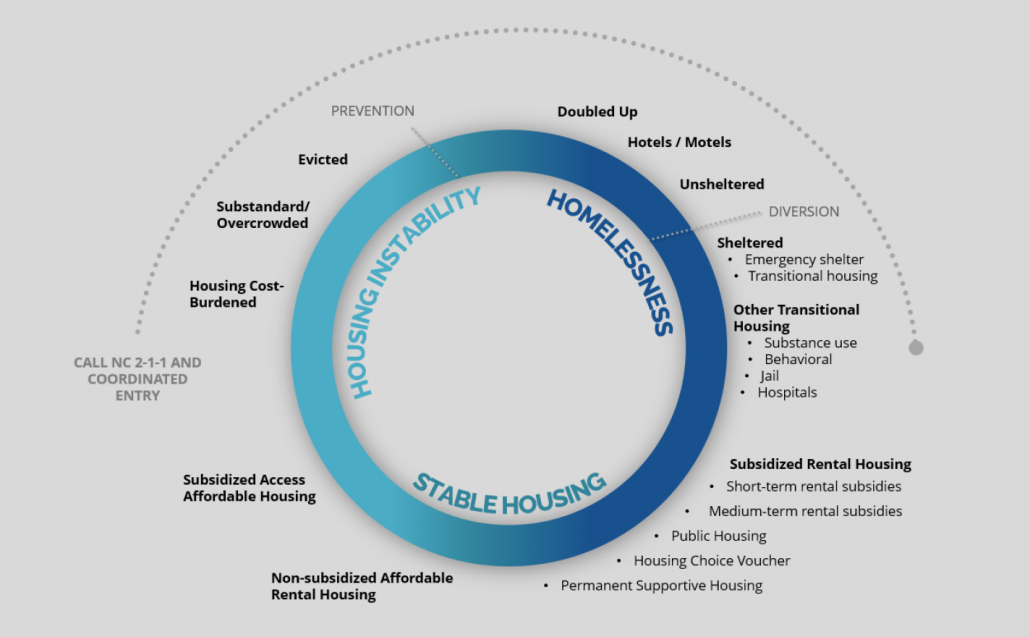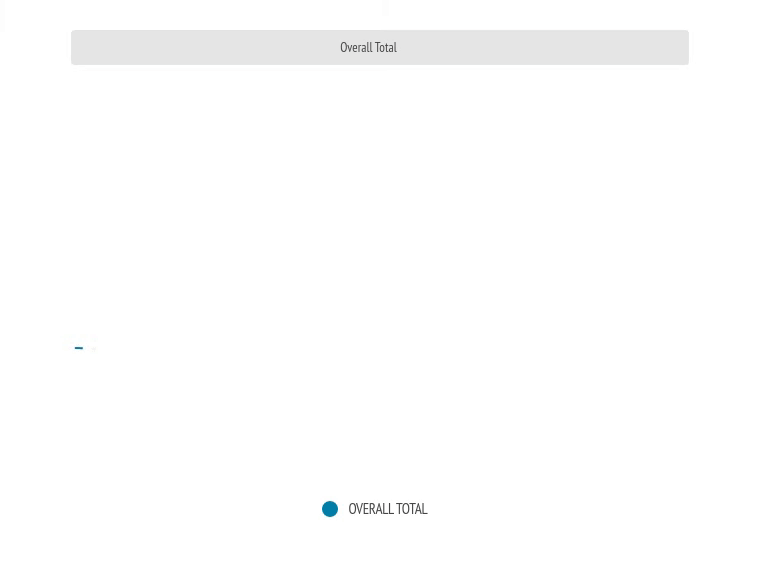Courtney LaCaria
Housing & Homelessness Research Coordinator
Mecklenburg County Community Support Services
Last year, the Building Bridges Blog launched a new, monthly data update: the Housing & Homelessness Continuum Data Update, which is intended to be part of our continuous improvement program. The Housing & Homelessness Continuum (HHC) will progress the community from a focus on the Point-in-Time Count, One Number and other disparate data sources to reliance on a more comprehensive and inclusive data set that reflects the full continuum from housing instability to homelessness.
The One Number is a monthly census that includes sheltered and a portion of unsheltered homelessness. The One Number has also been subject to continuous improvement methodologies. However, even with the advances made to enumerating homelessness using the One Number, there are still many households who experience housing instability and homelessness and who are not captured in the data inputs. It is critical to identify the households “in the gap” to both understand the full need for services, and to construct effective solutions to address these needs.
This approach is also called out as a need in the A Home for All Strategic Framework: identifying and closing the remaining gaps in data collection and reporting across the full housing continuum. To that end, this week’s blog will provide the latest updates regarding both housing instability and homelessness for the data sources we currently have; and highlight the areas in which gaps exist as well as the work underway to address those gaps. Finally, the blog will share what the latest trends show, and what all of this could mean for Charlotte-Mecklenburg.
Housing & Homelessness Continuum: the Latest Data
The graphic depicted below helps visualize the interrelationship of all the components comprising the full housing continuum. Immediately following are definitions for housing instability and homelessness. Finally, a table is provided with the latest system-level metrics.
Housing Instability
Housing Instability is a type of housing status. It exists along the housing and homelessness continuum. Housing instability can occur when an individual or household experiences any of the following: living in overcrowded and/or substandard housing; difficulty paying rent or mortgage; experiencing frequent moves due to personal economic or affordability reasons; doubling up with family or friends; or living in hotels. Cost-burden is frequently used as a measure of housing instability. Many people who become homeless have first faced housing instability.
Housing Instability Data
The chart below provides the latest data on housing instability using available system-level approximations.
Current Data Gaps
- Total number of households facing informal evictions
- Total number of households in substandard/overcrowded housing
- Total number of households facing foreclosure
- Total number of households on the Housing Choice Voucher waiting list
- Total number of households experiencing housing instability and seeking assistance for housing
Homelessness
Homelessness is another type of housing status that exists along the housing instability & homelessness continuum. Homelessness, by definition, means the loss of housing. Homelessness can occur when a household lacks a fixed, regular, and adequate nighttime residence. This can include doubling up with family and/or friends; paying to stay week to week in hotels/motels; temporarily residing in a shelter and/or transitional housing facility; experiencing unsheltered homelessness; exiting an institutional setting within a set period after previously experiencing homelessness; and/or fleeing domestic violence. The definition of homelessness employed varies by funding source.
Homelessness Data
The chart below provides the latest data on homelessness using available system-level approximations.
Current Data Gaps
- Total number of households experiencing homelessness in doubled up situations and/or in paying to stay in hotels/motels
- Total number of households experiencing nsheltered homelessness throughout the year
- Total number of households experiencing sheltered homelessness staying in a facility provided by a non-HMIS provider
- Total number of households experiencing other forms of homelessness, including in other forms of Transitional Housing and/or in substance use, behavioral health residential treatment
facilities, jails, and/or hospitals
Homelessness Trends
The chart below provides the historical change in One Number totals including the total number of people experiencing homelessness, single individuals, families, unaccompanied youth, Veterans, and people experiencing chronic homelessness.
To read more about the latest trends and analysis as well as access disaggregated One Number data by race and ethnicity and by age, click here.
SO, WHAT
Enumerating the number of people who need housing assistance across the entire housing continuum is difficult. We are reminded of this each year as our community completes the federally required Point-in-Time Count. A lot of time and effort goes into executing the one-night census; and for good reason, as “checking the box” on the activity helps ensure that we maintain, at minimum, the same level of federal assistance in the community for housing and homelessness services. While the data is important to inform federal funding decisions, the results from the Point-in-Time Count are not the most relevant data for helping local decision-makers. This is because the Point-in-Time Count provides only a sliver of the overall picture: a one-night snapshot of one segment of the overall population experiencing homelessness. More importantly, we have better data we can put to use.
But there are helpful aspects of the Point-in-Time Count that communities like Charlotte-Mecklenburg can expand upon to improve data collection as a system. For example, the Point-in-Time Count standardizes the process for counting a specific population experiencing homelessness across hundreds of communities in the United States. That, alone, is a herculean task. This is why all communities are required to count around the same time at the end of January; use an approved methodology to conduct the count; and employ a standard definition for who to count.
So, how can communities like ours take the principles that lead to standardization, and build upon them so that we can start to close other gaps across the system? We are excited to share that this year, thanks to our partners our Charlotte-Mecklenburg Schools, we are able to report on the number of students experiencing homelessness on the night of the Point-in-Time Count. For the first time, we have a single point of comparison for those two populations. (This data will be released as part of the 2022 State of Housing Instability & Homelessness Report in the Fall of 2022).
We are also fortunate to have systems-focused data collection tools, like the Housing Management and Information System (HMIS), which include multiple housing and homeless providers as well as numbers of households seeking assistance from Coordinated Entry. This data is collected throughout the year; and not just on one night in January. However, overall housing continuum input data is still fragmented.
The reasons for this fragmentation are as varied as the fragments, themselves. Taking just one example, there are many different definitions of homelessness; these definitions vary by the funding source or oversight body intended to address the problem. This inherently means that the reporting of data across the housing continuum is similarly segmented. Different programs serve different populations, who in turn fall in different places along the homelessness continuum.
Last year, the Homeless Children and Youth Act of 2021 was introduced with bipartisan support to align the definition of homelessness across federal agencies. Among other changes, this would fix one of the biggest homelessness definitions disconnects: the narrow definition of homelessness from the U.S. Department of Housing & Urban Development would be expanded to encompass the broader definition used by the U.S. Department of Education.
The definition for homelessness within the new A Home for All Strategic Framework is intentionally broad, and inclusive of all existing definitions. But without a standardized intake assessment and data collection process for everyone on the full housing continuum, and without a single mechanism to aggregate and de-duplicate the data collected, it is difficult (if not impossible) to look at all housing and homelessness data at a true systems level. For that reason, missing data and gaps will continue to be highlighted until they are closed.
It is essential that communities, like Charlotte-Mecklenburg, have the fullest possible picture to quantify need; estimate cost; secure funding; implement solutions; and evaluate results. Having that information would help communities respond more quickly in times of crisis, as with the pandemic; or in times of opportunity, such as with the influx of funding to address COVID-related concerns.
Knowing who is actually in need, and where those individuals and families are situated along the housing instability and homelessness continuum, is absolutely critical to the success of any effort, especially a coordinated one. Having access to this data will allow for not only maximizing new American Rescue Plan Act (ARPA) dollars, but all the other public and private resources focused on ending and preventing homelessness in Charlotte-Mecklenburg. Data is a key tool in the community constructing A Home For All.
SIGN UP FOR BUILDING BRIDGES BLOG
Courtney LaCaria coordinates posts on the Building Bridges Blog. Courtney is the Housing & Homelessness Research Coordinator for Mecklenburg County Community Support Services. Courtney’s job is to connect data on housing instability, homelessness and affordable housing with stakeholders in the community so that they can use it to drive policy-making, funding allocation and programmatic change.




